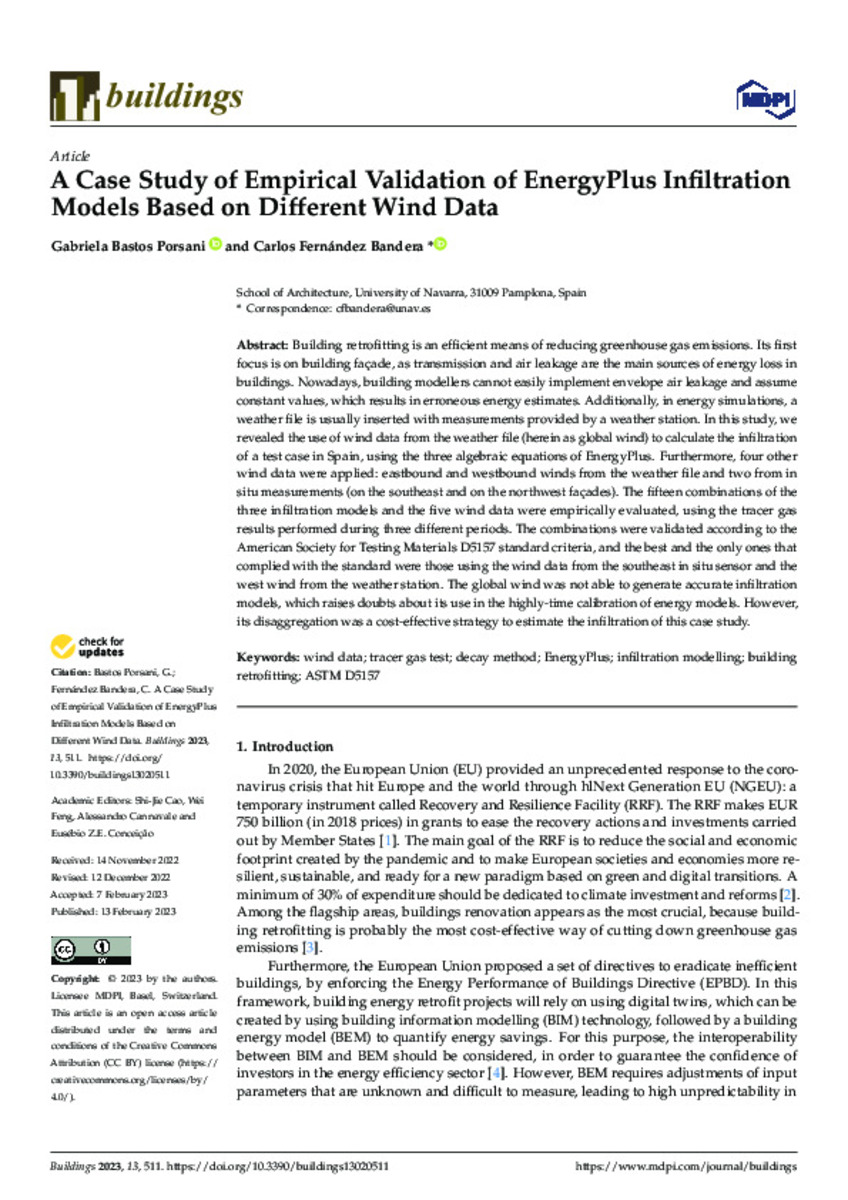Full metadata record
| DC Field | Value | Language |
|---|---|---|
| dc.creator | Bastos-Porsani, G. (Gabriela) | - |
| dc.creator | Fernández-Bandera, C. (Carlos) | - |
| dc.date.accessioned | 2023-11-21T10:30:30Z | - |
| dc.date.available | 2023-11-21T10:30:30Z | - |
| dc.date.issued | 2023 | - |
| dc.identifier.citation | Bastos-Porsani, G. (Gabriela); Fernández-Bandera, C. (Carlos). "A case study of empirical validation of EnergyPlus infiltration models based on different wind data". Buildings. 13 (2), 2023, 511 | es_ES |
| dc.identifier.issn | 2075-5309 | - |
| dc.identifier.uri | https://hdl.handle.net/10171/67909 | - |
| dc.description.abstract | Building retrofitting is an efficient means of reducing greenhouse gas emissions. Its first focus is on building façade, as transmission and air leakage are the main sources of energy loss in buildings. Nowadays, building modellers cannot easily implement envelope air leakage and assume constant values, which results in erroneous energy estimates. Additionally, in energy simulations, a weather file is usually inserted with measurements provided by a weather station. In this study, we revealed the use of wind data from the weather file (herein as global wind) to calculate the infiltration of a test case in Spain, using the three algebraic equations of EnergyPlus. Furthermore, four other wind data were applied: eastbound and westbound winds from the weather file and two from in situ measurements (on the southeast and on the northwest façades). The fifteen combinations of the three infiltration models and the five wind data were empirically evaluated, using the tracer gas results performed during three different periods. The combinations were validated according to the American Society for Testing Materials D5157 standard criteria, and the best and the only ones that complied with the standard were those using the wind data from the southeast in situ sensor and the west wind from the weather station. The global wind was not able to generate accurate infiltration models, which raises doubts about its use in the highly-time calibration of energy models. However, its disaggregation was a cost-effective strategy to estimate the infiltration of this case study. | es_ES |
| dc.description.sponsorship | The author, Gabriela Bastos Porsani, has received funding from a PhD scholarship programme called ”Asociación de Amigos de la Universidad de Navarra" of the University of Navarra, Spain. | es_ES |
| dc.language.iso | eng | es_ES |
| dc.publisher | MDPI | es_ES |
| dc.rights | info:eu-repo/semantics/openAccess | es_ES |
| dc.subject | Wind data | es_ES |
| dc.subject | Tracer gas test | es_ES |
| dc.subject | Decay method | es_ES |
| dc.subject | EnergyPlus | es_ES |
| dc.subject | Infiltration modelling | es_ES |
| dc.subject | Building retrofitting | es_ES |
| dc.subject | ASTM D5157 | es_ES |
| dc.title | A case study of empirical validation of EnergyPlus infiltration models based on different wind data | es_ES |
| dc.type | info:eu-repo/semantics/article | es_ES |
| dc.description.note | This article is an open access article distributed under the terms and conditions of the Creative Commons Attribution | es_ES |
| dc.identifier.doi | 10.3390/buildings13020511 | - |
| dadun.citation.number | 2 | es_ES |
| dadun.citation.publicationName | Buildings | es_ES |
| dadun.citation.startingPage | 511 | es_ES |
| dadun.citation.volume | 13 | es_ES |
Files in This Item:
Statistics and impact
Items in Dadun are protected by copyright, with all rights reserved, unless otherwise indicated.






